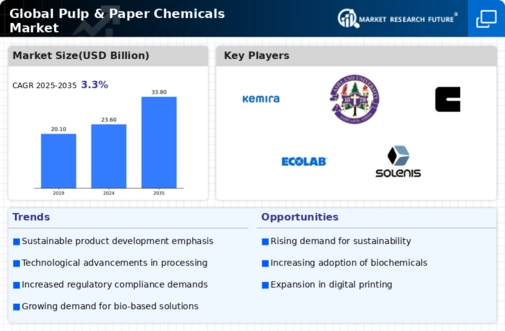Pulp Paper Chemicals Size
Pulp & Paper Chemicals Market Growth Projections and Opportunities
The market factors influencing the pulp and paper chemicals market are varied and complex, encompassing both internal and external dynamics that impact supply, demand, and pricing. One significant factor is the overall economic conditions and growth rates, as the pulp and paper industry is closely tied to broader economic trends. During periods of economic expansion, there tends to be higher demand for paper products, driving up the need for chemicals used in their production.
Pulp & paper chemicals are specialty chemicals used in the paper manufacturing from processing of pulp to the final product paper. These chemicals are used to optimize the production process of paper and help achieve the desired properties of paper such as brightness, strength and size whilst reducing the production cost. The major customers of pulp & paper chemicals are the pulp processors, paperboard and tissue producers, printing paper, and other general paper product manufacturers.
Additionally, government regulations play a crucial role in shaping the market for pulp and paper chemicals. Environmental regulations, in particular, have a significant impact on the types of chemicals that can be used in manufacturing processes. Stricter regulations aimed at reducing pollution and promoting sustainability may require the use of more environmentally friendly chemicals or processes, which can affect both supply chains and costs.
Technological advancements also influence the pulp and paper chemicals market, as new innovations can lead to more efficient production methods or the development of novel chemical formulations. Companies that invest in research and development to improve their products or processes may gain a competitive edge in the market, driving shifts in demand and pricing.
Raw material availability and costs are another critical factor for the pulp and paper chemicals market. Many chemicals used in paper production are derived from natural resources such as wood pulp or minerals. Fluctuations in the availability or pricing of these raw materials can have a direct impact on the cost of production for chemical manufacturers, which may be passed on to customers in the form of higher prices for pulp and paper chemicals.
Market consolidation and competition also play a role in shaping the dynamics of the pulp and paper chemicals market. As larger companies acquire smaller competitors or merge with other firms, they may gain greater control over supply chains and pricing power. This can lead to increased concentration within the industry and potentially limit choices for customers.
Globalization has further influenced the pulp and paper chemicals market, as companies seek to expand their operations into new regions or source raw materials from different locations. Changes in trade policies, currency exchange rates, and geopolitical tensions can all impact the flow of goods and services within the industry, creating both opportunities and challenges for market participants.
Consumer preferences and trends also drive demand for pulp and paper products, which in turn affects the market for chemicals used in their production. As environmental awareness grows, there has been a shift towards sustainable and eco-friendly paper products, leading to increased demand for chemicals that enable more environmentally friendly manufacturing processes.










Leave a Comment